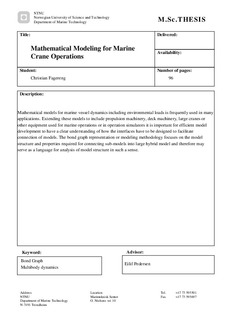| dc.contributor.author | Fagereng, Christian | nb_NO |
| dc.date.accessioned | 2014-12-19T12:06:40Z | |
| dc.date.available | 2014-12-19T12:06:40Z | |
| dc.date.created | 2012-02-08 | nb_NO |
| dc.date.issued | 2011 | nb_NO |
| dc.identifier | 493471 | nb_NO |
| dc.identifier.uri | http://hdl.handle.net/11250/237972 | |
| dc.description.abstract | As mathematical models for marine vessel dynamics are frequently used for several different purposes there is a need for finding ways of facilitating connection of sub models to extend these models to include various equipment of interest which affects the vessel dynamics. The bond graph modeling language is a natural platform for this since it can be used to describe several different disciplines or energy domains using the same basic system elements. Thus for example electrical systems affecting mechanical systems can easily be modeled and connected.
However the basic bond graph modeling concept has to be extended for use in multi-dimensional problems since standard procedures soon become difficult or impossible for larger systems. Using rigid body dynamics such systems can easily be created and incorporated with vessel dynamic equations. Rigid body bond graph can also be used to develop models of various other equipment. But when connecting several such systems together rigidly, causality problems will arise. The solution is to use the mathematical equivalent to a stiff spring in between the rigid bodies, thus the connection will not be entirely rigid.
In this thesis the development of such multi-dimensional bond graph has been research. A model for a simplified barge has been developed. It is clear that such models has great potential, but as with all other mathematical models of marine vessel dynamics accurate simulation results rely on accurate hydrodynamic coefficients which can be hard to derive.
Using the same procedure for multi-dimensional bond graph as for vessel modeling it is possible derive a model representing a pendulum. Which with some modification such as actuators represent a crane beam. Using three dimensional bond graph joints based on the concept of stiff springs to connect several such models a crane model is developed. The model is tested and it is found that the stiff springs in the connections may induce high vibrational natural frequencies which can affect simulation time. For such problems damping in the joint may be adopted.
The barge model and the crane model are interfaced using bond graph joints and it is shown that the movement of the crane indeed will induce forces on the barge as expected. This proves that 6DOF systems (six degrees of freedom) for several different mechanical component can be interfaced and facilitate the modeling of marine vessel dynamics and the connection of sub systems. Thus an efficient way of modeling such systems has been achieved.
To demonstrate the simulation result of the models developed in the thesis animations have been generated and is included in the attached CD. | nb_NO |
| dc.language | eng | nb_NO |
| dc.publisher | Norges teknisk-naturvitenskapelige universitet, Fakultet for ingeniørvitenskap og teknologi, Institutt for marin teknikk | nb_NO |
| dc.title | Mathematical Modeling for Marine Crane Operations | nb_NO |
| dc.type | Master thesis | nb_NO |
| dc.contributor.department | Norges teknisk-naturvitenskapelige universitet, Fakultet for ingeniørvitenskap og teknologi, Institutt for marin teknikk | nb_NO |
